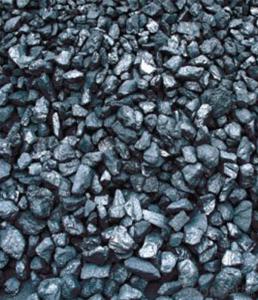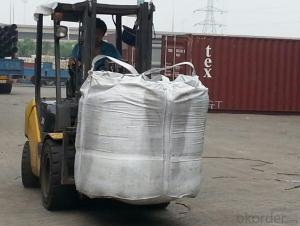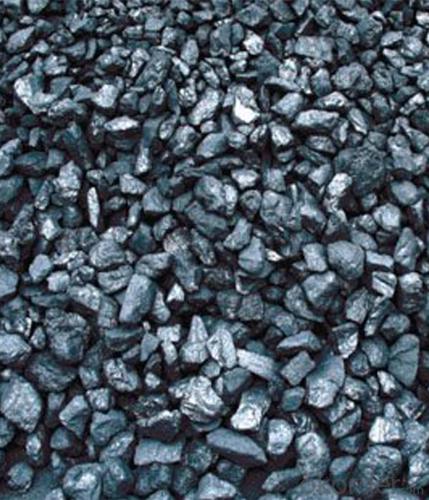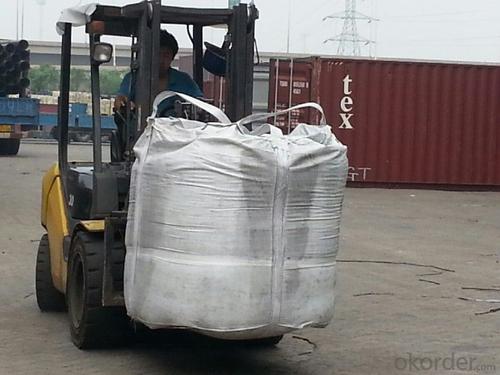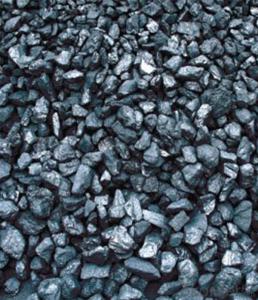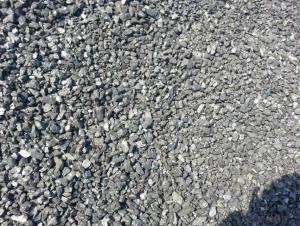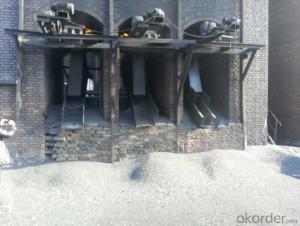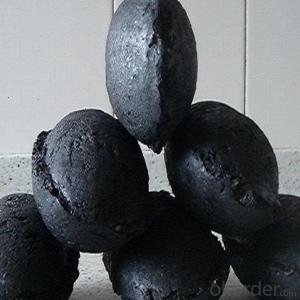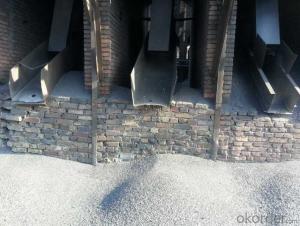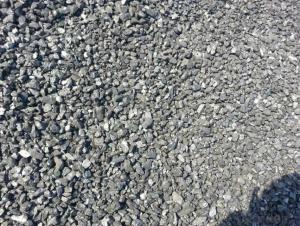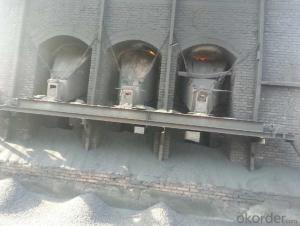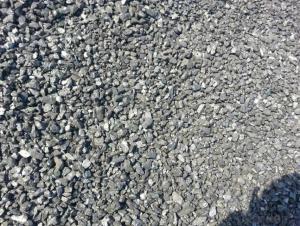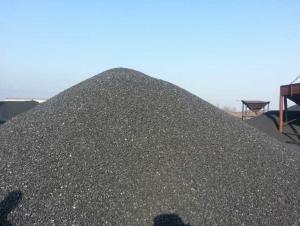Injection carbon FC92 with high and stable quality
- Loading Port:
- Tianjin
- Payment Terms:
- TT OR LC
- Min Order Qty:
- 20 m.t.
- Supply Capability:
- 3000 m.t./month
OKorder Service Pledge
OKorder Financial Service
You Might Also Like
Packaging & Delivery
25kgs/50kgs/1ton per bag or as buyer's request
Specifications
Calcined Anthracite
Fixed carbon: 90%-95%
S: 0.5% max
Size: 0-3. 3-5.3-15 or as request
It used the high quality anthracite as raw materials through high temperature calcined at over 2000 by the DC electric calciner with results in eliminating the moisture and volatile matter from anthracite efficiently, improving the density and the electric conductivity and strengthening the mechanical strength and anti-oxidation. It has good characteristics with low ash, low resistvity, low sulphur, high carbon and high density. It is the best material for high quality carbon products.
Advantage and competitive of caclined anthracite:
1. strong supply capability
2. fast transportation
3. lower and reasonable price for your reference
4.low sulphur, low ash
5.fixed carbon:95% -90%
6..sulphur:lower than 0.3%
General Specification of Calcined Anthracite:
| FC | 95 | 94 | 93 | 92 | 90 |
| ASH | 4 | 5 | 6 | 6.5 | 8.5 |
| V.M. | 1 | 1 | 1 | 1.5 | 1.5 |
| S | 0.3 | 0.3 | 0.3 | 0.35 | 0.35 |
| MOISTURE | 0.5 | 0.5 | 0.5 | 0.5 | 0.5 |
Pictures
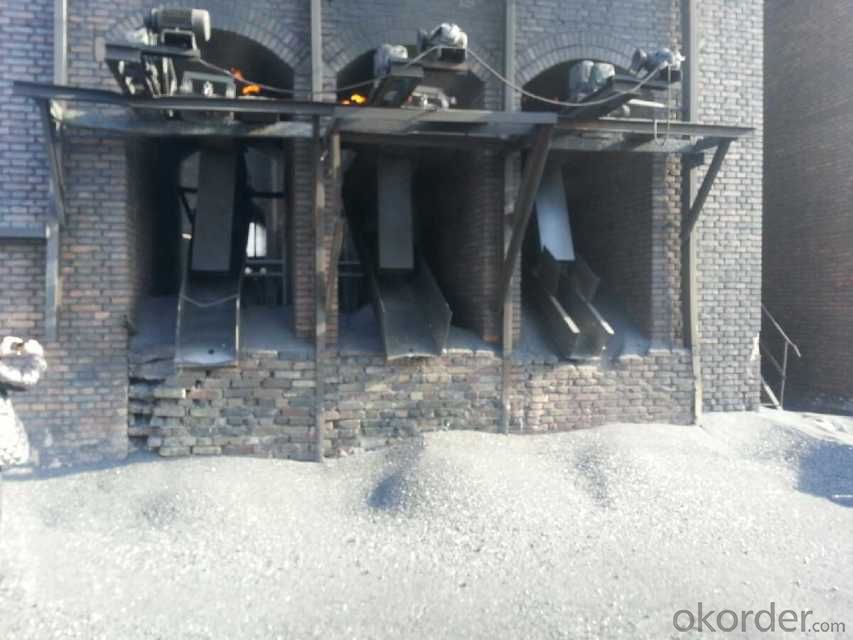
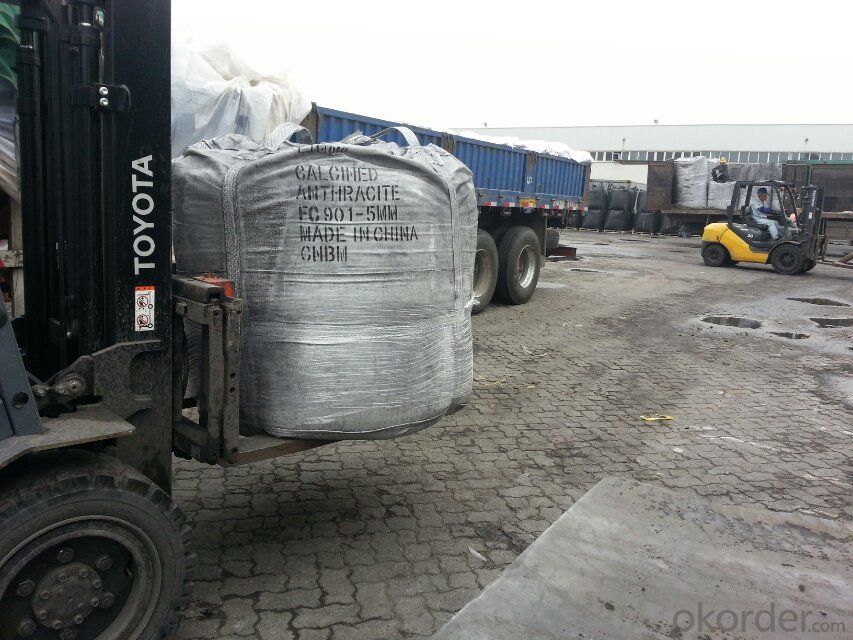
- Q: There is a graphite mine, looking for three experts engaged in mineral processing industry asked. They say earthy graphite, and the answer to the taste is quite different. Some say that the fixed carbon content of 15, and some say graphite grade 90%. The same sample. Some people say that very valuable, and some say that the grade is too low, worthless. I'm all confused. What do you mean by graphite grade and fixed carbon?
- The taste of graphite powder refers to its purity, that is, the amount of carbon; fixed carbon content refers to the removal of water, ash and volatile residues, it is an important indicator of the use of coal. The two are essentially different
- Q: How does carbon affect the growth of plants?
- Plants rely on carbon for their growth and development, as it is a vital element. It is found in organic compounds like carbohydrates, proteins, and lipids, which are essential for plants' metabolic processes. Photosynthesis allows plants to convert carbon dioxide into glucose and other sugars, providing them with energy for various functions and growth. Additionally, carbon plays a crucial part in building plant structures. Cellulose, a complex carbohydrate composed of carbon, hydrogen, and oxygen, gives rigidity and support to plant cell walls, enabling them to maintain their shape and withstand mechanical stress. Lignin, another carbon-based compound, strengthens stems and roots, allowing plants to grow upright and resist bending or breaking. Moreover, carbon has a role in regulating plant hormones and signaling molecules that control growth and development. It acts as a foundation for the synthesis of various plant hormones, such as auxins, gibberellins, and cytokinins, which influence cell division, elongation, and differentiation. To summarize, carbon is crucial for plant growth as it fuels their energy needs, provides structural support, and participates in hormonal regulation. Understanding the significance of carbon in plant growth is essential for optimizing agricultural practices, ensuring healthy crop yields, and mitigating the impact of climate change on plant ecosystems.
- Q: How does carbon impact the availability of clean transportation?
- Carbon emissions from burning fossil fuels contribute to climate change, which affects the availability of clean transportation. Increased levels of carbon dioxide in the atmosphere trap heat, leading to rising global temperatures and extreme weather events. This, in turn, impacts the infrastructure necessary for clean transportation, such as roads, bridges, and railways. Additionally, carbon-intensive transportation systems, like gasoline-powered vehicles, contribute to air pollution, which further hinders the development and adoption of cleaner transportation alternatives like electric vehicles.
- Q: There are ten carbon and oil Gulu chorus, carbon English Gollum and finally he said to sing, this is English this is the song of English is what?
- It's BAD AND NITHTDuring Halloween last year, many people joined in the chorusThe English sounds are are, you, ready and where you goingBecause the pronunciation and intonation is very interesting, so has been Tucao
- Q: What are the effects of carbon emissions on the Arctic ecosystem?
- The Arctic ecosystem is significantly impacted by carbon emissions, primarily due to global warming. The release of carbon dioxide and other greenhouse gases into the atmosphere traps heat, leading to increased temperatures worldwide. However, the Arctic is particularly susceptible to these effects because of its unique characteristics. One of the most noteworthy consequences of carbon emissions on the Arctic ecosystem is the rapid melting of ice. Increasing temperatures cause glaciers and ice sheets to decrease in size, resulting in the loss of habitat for ice-dependent species like polar bears, walruses, and seals. These animals not only depend on the ice for resting and breeding but also for hunting and finding food. The reduction of their natural habitat has led to a decline in their populations, impacting the delicate balance of the Arctic food chain. Moreover, the melting of ice leads to rising sea levels, which can have cascading effects on coastal areas. Many Arctic communities, including indigenous peoples, are located near the coast and rely on the sea for their livelihoods. The increase in erosion, flooding, and storm surges due to rising sea levels pose a threat to their homes, infrastructure, and traditional ways of life. Furthermore, carbon emissions contribute to ocean acidification, a process in which excess carbon dioxide absorption by seawater lowers its pH level. This acidification has detrimental effects on marine organisms such as shellfish, corals, and plankton, which struggle to build and maintain their calcium carbonate structures. These organisms serve as essential food sources for various Arctic species, including fish, seabirds, and marine mammals. The decline in their populations disrupts the intricate web of life in the Arctic and can have far-reaching consequences. Climate change caused by carbon emissions also disrupts the timing and patterns of seasonal events, such as plant growth, bird migration, and the availability of food resources. This mismatch can have severe consequences for species that rely on specific timing for reproduction, migration, and survival. In summary, the effects of carbon emissions on the Arctic ecosystem are significant and extensive. The loss of sea ice, rising sea levels, ocean acidification, and disrupted ecological processes all contribute to the vulnerability of Arctic species and communities. Urgent action to reduce carbon emissions, mitigate climate change, and protect this fragile ecosystem is crucial for the long-term preservation of the Arctic.
- Q: What are the impacts of carbon emissions on the stability of mountain glaciers?
- Carbon emissions have a significant impact on the stability of mountain glaciers. As carbon dioxide and other greenhouse gases accumulate in the atmosphere, they trap heat and contribute to global warming. This increase in temperature leads to accelerated melting of mountain glaciers, reducing their size and volume. The loss of glaciers not only affects the availability of freshwater resources but also disrupts local ecosystems, alters river flows, and poses a risk of glacial lake outburst floods. Moreover, melting glaciers contribute to rising sea levels, which can have far-reaching consequences for coastal communities and low-lying areas. Therefore, reducing carbon emissions is crucial to mitigate the adverse effects on the stability of mountain glaciers and preserve these vital natural resources.
- Q: The dangers of grilled BBQ on humansWhat are the dangers of a charcoal barbecue?
- In fact, almost all the food will produce carcinogenic substances after fried, roasted, fried, fried and other high-temperature cooking treatment, like French fries, fried taro balls, fried doughnuts, after frying or baking starchy foods, they contain a large number of acrylamide (Acrylamide) in animal experiments. Propylene amine, can lead to the formation of DNA appendages, which caused the increase of gene mutation, carcinogenic risk.The fry roast fried etc., cooked food is easy to make the body acidic, the pH value is out of balance.To understand this relationship, in order to avoid carcinogenic substances harmful to our body, suggest to eat fried, fried, fried and grilled food, if in case of major occasions of unwillingness, demand, entertainment or banquet, it is best to take a Monday time limit; and don't forget to drink fresh juice Vegetable & Fruit one day, the best able to drink four to six cups, in order to remove toxins and supply immunity and self-healing system enough plant biochemical elements.
- Q: What are the effects of carbon emissions on the stability of alpine ecosystems?
- The effects of carbon emissions on the stability of alpine ecosystems are significant and far-reaching. Carbon emissions, primarily in the form of carbon dioxide, contribute to the greenhouse effect and subsequent climate change. This leads to a series of impacts that directly affect the stability of alpine ecosystems. One of the most noticeable effects is the increase in global temperatures. As temperatures rise, glaciers and snow caps in alpine regions melt at accelerated rates. This has a profound impact on the availability of freshwater resources, as alpine regions are often the source of major rivers and lakes. Reduced water availability not only affects the survival of plant and animal species but also impacts human populations relying on these water sources for agriculture, drinking water, and hydropower generation. Another consequence of carbon emissions is the alteration of precipitation patterns. Climate change disrupts the balance of rainfall and snowfall in alpine ecosystems, leading to more frequent and severe droughts or intense rainfall events. Such changes in precipitation patterns can result in soil erosion, landslides, and the overall destabilization of alpine terrain. This poses a threat to the survival of alpine flora and fauna, as well as the loss of vital habitats and biodiversity. Furthermore, carbon emissions contribute to the acidification of alpine lakes and rivers. Increased carbon dioxide in the atmosphere dissolves in water bodies, forming carbonic acid. This acidification negatively affects aquatic organisms, such as fish and amphibians, by impairing their reproductive abilities, altering their behavior, and even causing mortality. It also disrupts the delicate balance of alpine freshwater ecosystems, leading to a decline in species diversity and ecological resilience. Lastly, carbon emissions can indirectly impact alpine ecosystems through the spread of invasive species. Climate change creates favorable conditions for the expansion of non-native plant and animal species into higher elevations. These invasive species can outcompete native flora and fauna, disrupt ecological interactions, and ultimately lead to the displacement or extinction of native species. This disrupts the natural balance of alpine ecosystems and compromises their stability. In conclusion, carbon emissions have profound effects on the stability of alpine ecosystems. These emissions contribute to the melting of glaciers, alteration of precipitation patterns, acidification of water bodies, and the spread of invasive species. These impacts disrupt the balance of alpine ecosystems, leading to the loss of biodiversity, habitat degradation, and reduced availability of freshwater resources. Urgent action to mitigate carbon emissions is crucial to preserve the stability and functioning of these fragile ecosystems.
- Q: What kinds of carbon black paper do you have?
- Three, triad:And the triple carbon free carbon paper receipts can be divided into paper, medium paper and paper. The paper also called back coated paper (CB, Coated Back), the back of the paper coated with microcapsules containing force sensitive pigment oil; in the paper also called double coated paper (CFB, Coated Front and Back), the paper is coated with a chromogenic agent containing microcapsules coated on the back force sensitive pigment oil; the paper also called surface coated paper (CF, Coated Front), the paper only coated with chromogenic agent. Since the display paper (code SC, Self-Contained) is in the back of the paper coated with a layer of microcapsules containing force sensitive pigment oil, microcapsule coated positive chromogenic agent and pigment containing sensitive oil.Four, selection of carbonless paper:In the purchase and use of carbonless paper, preferably with the same company produced the same brand, paper collocation, production date and not apart for too long. Because the various manufacturers of products in brightness, color density, smoothness, thickness, stiffness, strength, color printing surface galling tone, compactness, ink and other indicators are different, so the different manufacturers of paper used in appearance, collocation, printability, collating, copying are affected.
- Q: How does carbon dioxide affect the health of marine organisms?
- The health of marine organisms can be significantly impacted by carbon dioxide. Seawater absorbs carbon dioxide, causing a chemical reaction that results in increased acidity, known as ocean acidification. Ocean acidification hampers the ability of numerous marine organisms to construct and maintain their shells and skeletons. Organisms like corals, oysters, and shellfish rely on calcium carbonate to form their protective structures. However, in more acidic conditions, the availability of carbonate ions decreases, making it more difficult for these organisms to calcify. This can result in weakened shells, reduced growth rates, and heightened susceptibility to predation and disease. Moreover, ocean acidification can disturb the reproductive and developmental processes of marine organisms. Higher levels of CO2 have been shown in some studies to affect fish's ability to locate preferred habitats, find mates, and successfully reproduce. Additionally, certain species of fish and invertebrates demonstrate altered behavior and impaired sensory functions under high CO2 conditions. In addition to the direct effects, ocean acidification can also indirectly impact marine organisms by disrupting entire ecosystems. For example, the decline of coral reefs due to reduced calcification can have far-reaching effects on the entire reef ecosystem, affecting the biodiversity and productivity of these crucial marine habitats. In summary, the rising levels of atmospheric carbon dioxide not only contribute to global climate change but also lead to ocean acidification, posing significant threats to the health and survival of many marine organisms. It is imperative to address and mitigate the causes of carbon dioxide emissions to safeguard the delicate balance of our oceans and the diverse range of species that rely on them for survival.
Send your message to us
Injection carbon FC92 with high and stable quality
- Loading Port:
- Tianjin
- Payment Terms:
- TT OR LC
- Min Order Qty:
- 20 m.t.
- Supply Capability:
- 3000 m.t./month
OKorder Service Pledge
OKorder Financial Service
Similar products
Hot products
Hot Searches
